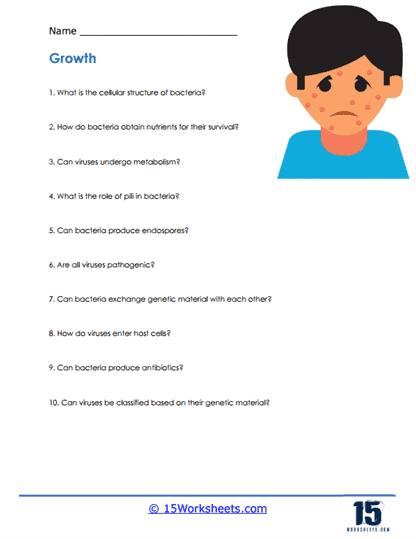Growth

Worksheet Description
The worksheet looks at the fundamental concepts associated with bacteria and viruses, particularly focusing on their cellular structure, metabolism, and interaction mechanisms. It features a series of questions that delve into how these microorganisms grow, reproduce, and interact with their environment. The representation of a concerned individual on the worksheet possibly underscores the implications of bacterial and viral growth in relation to human health. Through these questions, the worksheet seeks to provide students with an opportunity to explore the intricate dynamics of microbial life, emphasizing the processes that facilitate their growth and survival.
To successfully tackle this worksheet, students should initiate by reading each question attentively, ensuring they grasp the core of the inquiry. It would be beneficial for them to first recall and jot down their initial responses based on their existing knowledge of microbiology. For areas where they might feel uncertain, turning to reliable textbooks or academic online sources can be instrumental in obtaining comprehensive answers. Once all questions have been addressed, it’s recommended for students to either cross-check their responses with authoritative sources or engage in discussions with peers or educators, facilitating a more in-depth understanding.
This worksheet is tailored to impart to students an understanding of the fundamental principles surrounding the growth and survival mechanisms of bacteria and viruses. It aims to elucidate the intricacies of microbial cellular structures, metabolic processes, and interactions with host entities. By directing students to ponder upon the nature of microbial growth and how it affects the surrounding environment, especially humans, the worksheet encourages a holistic grasp of microbiology. The ultimate goal is to provide students with a foundational knowledge base, preparing them for more advanced studies and fostering an appreciation for the microscopic world’s complexities.
